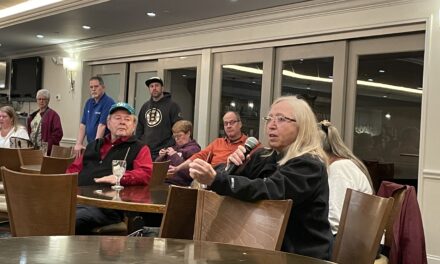Published in the February 1, 2018 edition
By MAUREEN DOHERTY
NORTH READING — It is rare when a project undertaken by the town involves direct interaction with virtually every residential and business property within its borders. But such is the case with the change-out of every water meter in town that will occur over the next eight or nine months.
The Selectmen were provided with an update on the implementation phase of this $1.7M capital improvement project that was approved and funded by the town over the last two fiscal years at their Jan. 22 meeting.
This is a “significant capital project” Town Administrator Michael Gilleberto explained, “that will have a very real and very direct impact on our residents in that we are talking about changing the meters that are located in their homes.” The direct impact on residents and business owners will occur between March and October when the outdated mechanical water meters in 4,500 homes and 300 businesses will be replaced, neighborhood by neighborhood.
DPW Director Andrew Lafferty explained that the funds to be expended cover the supplies needed to be purchased, including meters and associated hardware together with the “fixed network system” totaling $1,103,210; the installation of the meters and associated equipment at a cost of $513,322; and the engineering cost of $113,200. The project is under budget and “we hope to stay under budget,” he said.
It has been nearly three decades since the town upgraded all of its water meters.
“The existing water meters are 27 years old,” Lafferty said, adding the benefits to upgrading these meters include “improved leak detection, better customer service, increased meter reading and billing efficiency and reducing estimated bills and billing errors.”
The town put the project out to bid and has awarded contracts to three firms to complete this work. Weston & Sampson is the engineering firm providing construction administration services; Ti-Sales will supply the Neptune meters and the fixed network system that will enable the meters to be read remotely; and Thieslch Engineering and USI Services will install both the meters inside the home or business and the small modules to be mounted outside the home or business and connected to the meter that will enable each meter to be read remotely.
Weston & Sampson engineer Margaret McCarthy provided the board with the project timeline. The initial kickoff meeting with Thieslch occurred in January and they have begun to “finalize the location of the collectors which are going to be the towers that will collect the meter reading information,” she said.
They have also begun “billing system modifications that are needed in order to accept this new data that will be coming in,” McCarthy said.
Throughout February, McCarthy said they will “install the network that will be reading the meters and some test installations to make sure the billing system modifications are working properly before we start fully installing all 4,800 meters.”
Contacting water customers
Also beginning in February a coordinated effort will be undertaken to inform all of the town’s water customers about the water meter upgrade, beginning with a water bill insert notice and notification via the newspaper and website. Additionally, direct mail postcards to be sent by the meter installers, Thieslch/USI, will inform customers to arrange their installation appointments either by calling the toll-free number listed on the card or logging on to their website and providing USI Services with the work order and service code numbers located on the postcard’s address label.
It was emphasized that appointment times will be provided in two-hour blocks and the typical installation will take about 45 minutes or less to complete on average, including approximately 15 minutes during which water service to the home or business must be shut off. An adult aged 18 or older must be present when the installation occurs.
Appointments will be available between 8 a.m. and 4 p.m. Monday through Friday with a limited number of evening or weekend appointments. The company will also work with business customers that have special requirements when it comes to water usage for their operations to coordinate the least disruptive installation time.
To enable the installation to go as efficiently as possible, the company also requests that customers ensure a five-foot radius around the water meter is kept free of obstructions prior to their arrival.
The installer will also provide each customer with written instructions and an explanation on how to read the new water meters.
McCarthy said one of the reasons for replacing the water meters is to “provide customers with more information in terms of the water they’re using. The Neptune Register allows for readings down to one-tenth of a gallon. You do not get that granularity with the technology that is currently installed in the system.” This data capture will allow both “leak detection” and “backflow flagging” to be done, for example.
Customers will be provided information on the WaterSmart customer portal that will enable them to track their water usage at the “macro and micro levels” through automated alerts customized to their preferences, such as email, voice or text message, McCarthy said.
For example, usage detection alerts could potentially alert a customer to a spike in usage that could indicate either a major or minor leak in the system. This alert could potentially save the homeowner or business owner from property damage, especially if a spike in usage is detected when they are not on the premises and it is a major leak. The system will detect the level of the leak as well, noting it could be due to a flusher valve stuck open in a toilet versus a burst pipe, she said.
“They’ll also be provided ways to save money if they wanted to reduce their water bill,” McCarthy said.
Pilot testing
Water Superintendent Mark Clark explained that the pilot testing will occur in some of the town’s newer neighborhoods, such as MacIntyre Estates “which has all new meters and we know all the valves to shut off (the meters) will work in those houses. We want to get a quick number of meters in there for testing purposes.”
“But we will be going sequentially from neighborhood to neighborhood. We are not going to do a bulk mailing” of the appointment postcard, Clark said.
The benefit of doing the installations neighborhood by neighborhood will be eliminating the need to schedule appointments several months in advance while also making more efficient use of the technician’s time in the field.
McCarthy stressed that a background check is done on every USI installer. They will be wearing uniforms, driving clearly marked vehicles and have a photo ID badge displayed. The company will also keep the local police informed of the neighborhoods where they will be working “in case residents call about the installers” whose presence could be mistaken for suspicious activity.
More accurate water usage captured
Selectmen Chairman Mike Prisco asked what the impact on a customer’s water bill would be during the transition period from the old meter to the new meter.
McCarthy explained that since the existing water meters are “mechanical” they are prone to slow down over time. “A 27-year-old meter is not going to be registering the same volume of water that a new meter will. They do lose that accuracy over the time period. I cannot say by what percentage,” she said.
Clark added, “If we replace your meter mid-billing cycle on your next bill you will see your old meter data (and) your replacement volume will be factored in, plus the incremental volume from the new meter. We’ll capture all the water you used up to the date of the replacement and we’ll start again.”
Prisco said, “So residents potentially will see an increase in their bill only because their meter is now capturing the actual water usage?”
Clark said that is correct. “The bulk of our meters are in the 27-year age so with corrosion and internal mechanisms tend to slow down, so they may see an increase in water use just based on that if they have a very old meter,” he said.
Selectmen Bob Mauceri said he suspects there will be a certain percentage of meter installations where issues with shut off valves or plumbing inside the home may occur and pose potential problems or delays. “How is that addressed?” he asked.
Clark said, “We get calls on a weekly basis that a plumber’s in the house, he shut the valve before the meter off, now he has gone to open it up and it’s broken in the closed position. We’ll evaluate those on a case by case basis.” He said technicians familiar with the issue understand that “if the valve has a white or red handle on it I’m not touching it. Some valves from the ‘90s are more likely to break than those made in the 1950s that were made to a better standard.”
This means there will be instances where customers may need to call in a plumber to replace the older valves before the meter change-out occurs.
“We get this question a lot. We own the water meters that are in the home… We do not own the piping before the meter. We own to the shut off valve outside by the street. Beyond that the homeowner owns the service and they own that shut off valve before the meter, so a broken valve (is) the homeowner’s responsibility.” Clark said.
He added, “We don’t want to be in the position where we’ve shut it and now it’s broken in a closed position,” Clark said. If a plumbing issues is not detected until the technician arrives Clark said the installers would not proceed if it meant the homeowner would be left without water for longer than the estimated 15 minute installation and the appointment would be rescheduled.
Another option would be to have the service shut off at the street on the town’s side of the valve, install the meter and turn the water back on at the street.
Mauceri explained that issue happened to him while he was doing work at his own house. “I shut off a gate valve in the middle of the winter and it wouldn’t turn back on,” he said. Finding the shutoff valve outside proved to be a bit of a challenge, but it was eventually found in the middle of his lawn, he said.
Clark said there are definitely situations when water department workers show up at a customer’s house and realize they “won’t be touching that valve inside the house because it’s going to break.”
He said if the new meter detects a spike in usage it would indicate to the water department that it is coming from inside the home or business. “If you’re away we need access to your home to figure out what is going on. Anything that is registering on that meter is obviously on the home site of the meter. If it’s leaking on the street side it is not going to show up because the water hasn’t passed through the meter.”
Mauceri said a benefit to the having communication “direct from the meter is that unlike now, in the wintertime, some of the meters do not get read in the quarterly cycle and therefore it has impact and we’ve gotten complaints from some customers regarding pushing them into the next level of the water bill.”
Clark explained that with the new meters they “will be getting, hopefully, 24 readings every day from your home without leaving Town Hall. If we set it at quarterly billing which is 91 and a quarter days, wed could get down to that limit of accuracy… it takes us six weeks now to read the whole town.” Choosing the date of billing through the first couple cycles with the new meters in place is “something we got to work on,” he said, since the pricing of the water is tiered based on total usage.
Prisco said it was “wonderful” that background check would take place before installers were cleared to go into people’s homes.
O’Leary asked if the town is “allowed to mandate” entry into the home or business because “there will be some people who would be resistant,” he said.
McCarthy said doing so would likely require them to return to the board to make such a request but she said the town’s bylaws give the town “the right to replace the equipment that you own.”
“Margaret mentioned the ‘granularity,’ We bill in units of thousands of gallons,” Clark said, due to the mechanics of the existing meters. “If your home is using 200 gallons a day, for us, every fifth day there would be a blip in your water usage if we were reading it every day. The newest meters, we can read that to the closest tenth of a gallon so that’s 10,000 times the resolution we have with the older meters.
“We’ll be getting hourly reads on that meter, so whereas we are reading it every 91 days now when we manually read those meters, we’ll be getting 2,000-plus times meter readings from your meter,” said Clark.
“There is technology in that meter head that divides the day into 96 fifteen-minute intervals. If so many consecutive of those 15-minute intervals have actual positive water use in them the meter will notify us and it can notify you, through this WaterSmart, that we suspect there is water use in your home,” Clark said.




